Metcalfe's Food Company: Leadership, Management, and Operations Report
VerifiedAdded on 2020/06/06
|13
|3922
|47
Report
AI Summary
This report provides a comprehensive analysis of leadership and operational management within Metcalfe's Food Company. It begins by comparing the roles and characteristics of leaders and managers, highlighting their differing focuses and responsibilities. The report then explores various leadership theories, including situational and contingency approaches, and analyzes their strengths and weaknesses. Furthermore, the report delves into key operational management approaches, such as the dynamic and Six Sigma approaches, and discusses their importance in improving efficiency. The report also examines factors impacting the business environment and evaluates the application of operational management within the context of the food industry. The report concludes with an evaluation of the effectiveness of different leadership and operational strategies, offering insights into how Metcalfe's Food Company can enhance its performance and achieve its goals. This report is designed to assist students in understanding leadership and operational management principles.
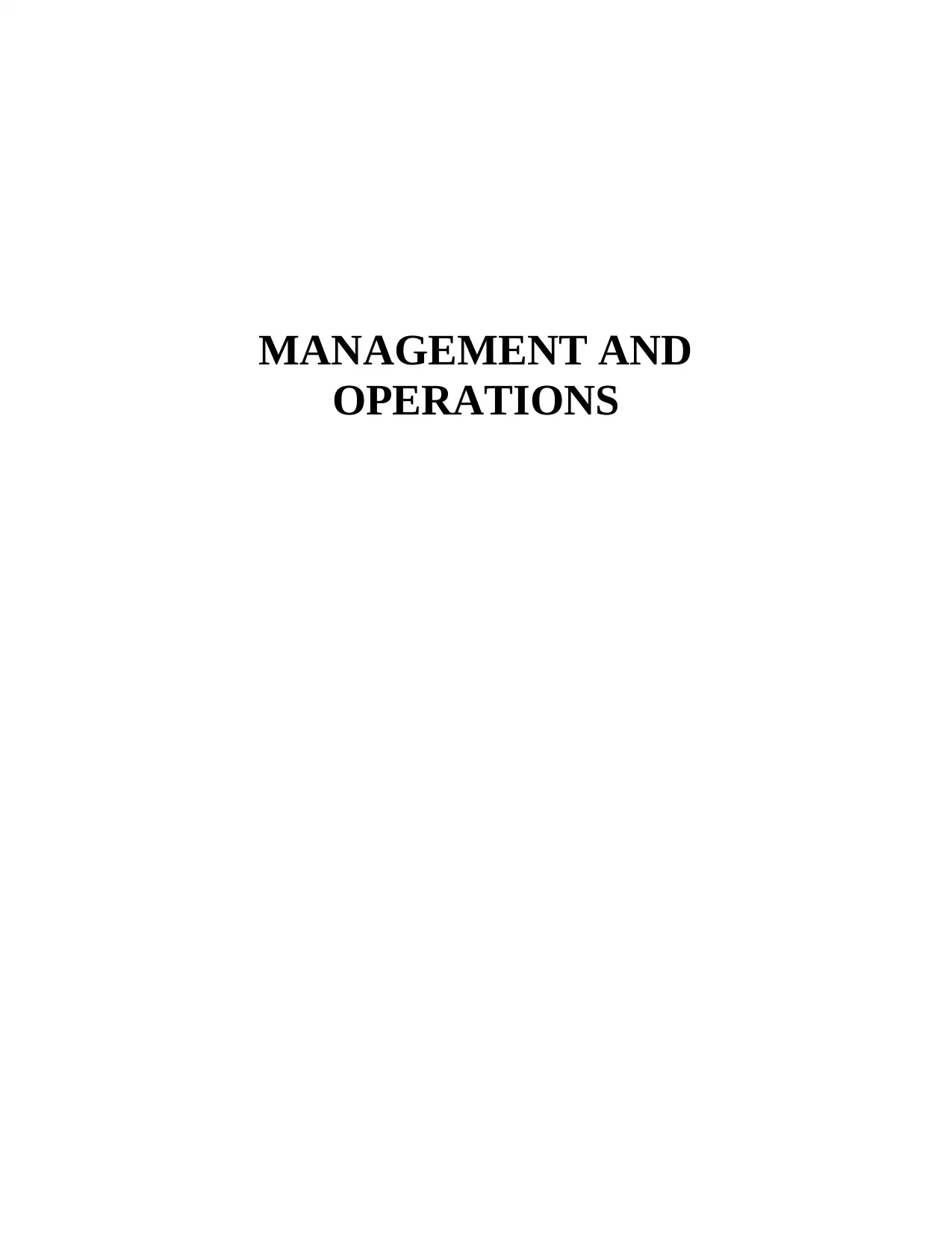
MANAGEMENT AND
OPERATIONS
OPERATIONS
Paraphrase This Document
Need a fresh take? Get an instant paraphrase of this document with our AI Paraphraser
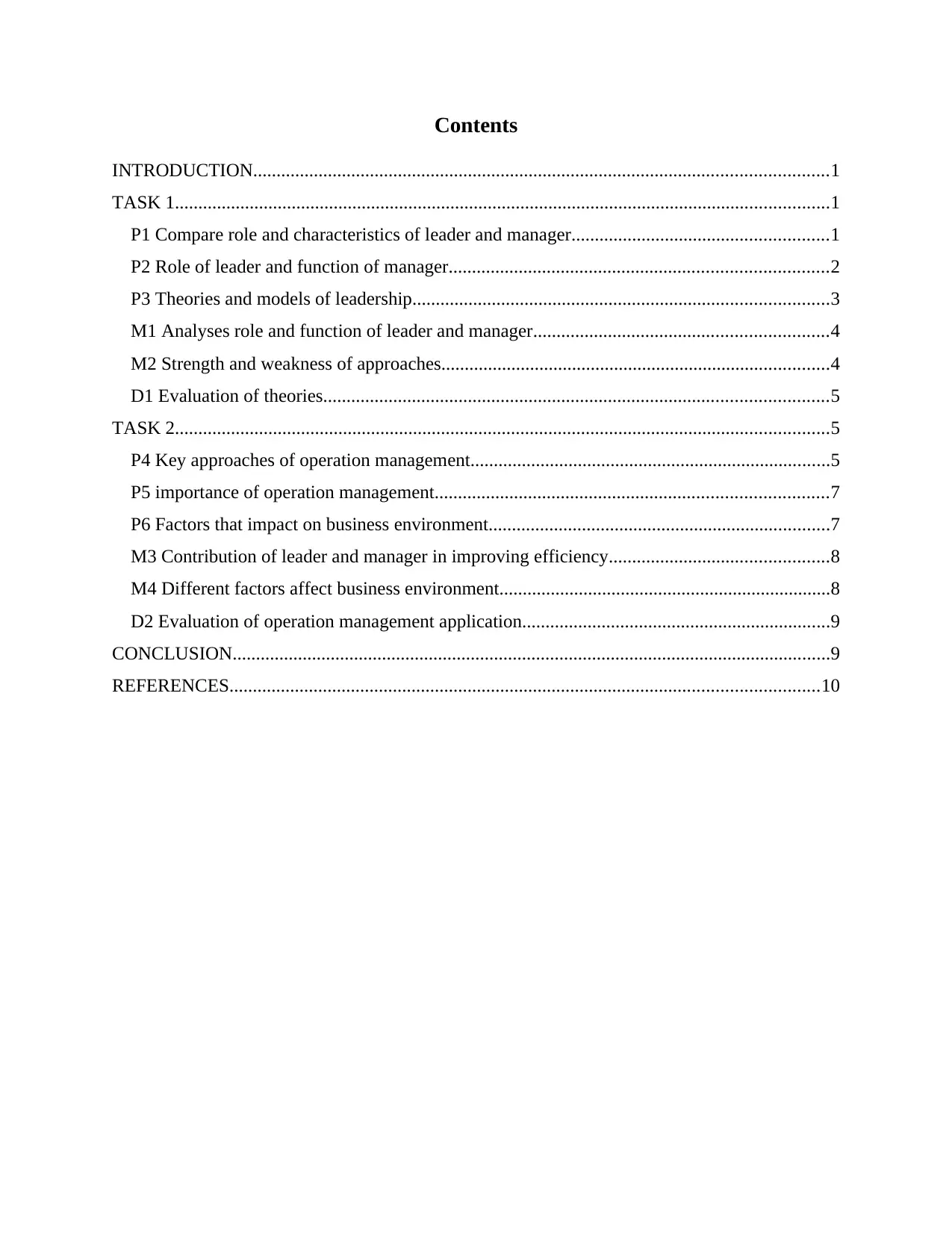
Contents
INTRODUCTION...........................................................................................................................1
TASK 1............................................................................................................................................1
P1 Compare role and characteristics of leader and manager.......................................................1
P2 Role of leader and function of manager.................................................................................2
P3 Theories and models of leadership.........................................................................................3
M1 Analyses role and function of leader and manager...............................................................4
M2 Strength and weakness of approaches...................................................................................4
D1 Evaluation of theories............................................................................................................5
TASK 2............................................................................................................................................5
P4 Key approaches of operation management.............................................................................5
P5 importance of operation management....................................................................................7
P6 Factors that impact on business environment.........................................................................7
M3 Contribution of leader and manager in improving efficiency...............................................8
M4 Different factors affect business environment.......................................................................8
D2 Evaluation of operation management application..................................................................9
CONCLUSION................................................................................................................................9
REFERENCES..............................................................................................................................10
INTRODUCTION...........................................................................................................................1
TASK 1............................................................................................................................................1
P1 Compare role and characteristics of leader and manager.......................................................1
P2 Role of leader and function of manager.................................................................................2
P3 Theories and models of leadership.........................................................................................3
M1 Analyses role and function of leader and manager...............................................................4
M2 Strength and weakness of approaches...................................................................................4
D1 Evaluation of theories............................................................................................................5
TASK 2............................................................................................................................................5
P4 Key approaches of operation management.............................................................................5
P5 importance of operation management....................................................................................7
P6 Factors that impact on business environment.........................................................................7
M3 Contribution of leader and manager in improving efficiency...............................................8
M4 Different factors affect business environment.......................................................................8
D2 Evaluation of operation management application..................................................................9
CONCLUSION................................................................................................................................9
REFERENCES..............................................................................................................................10
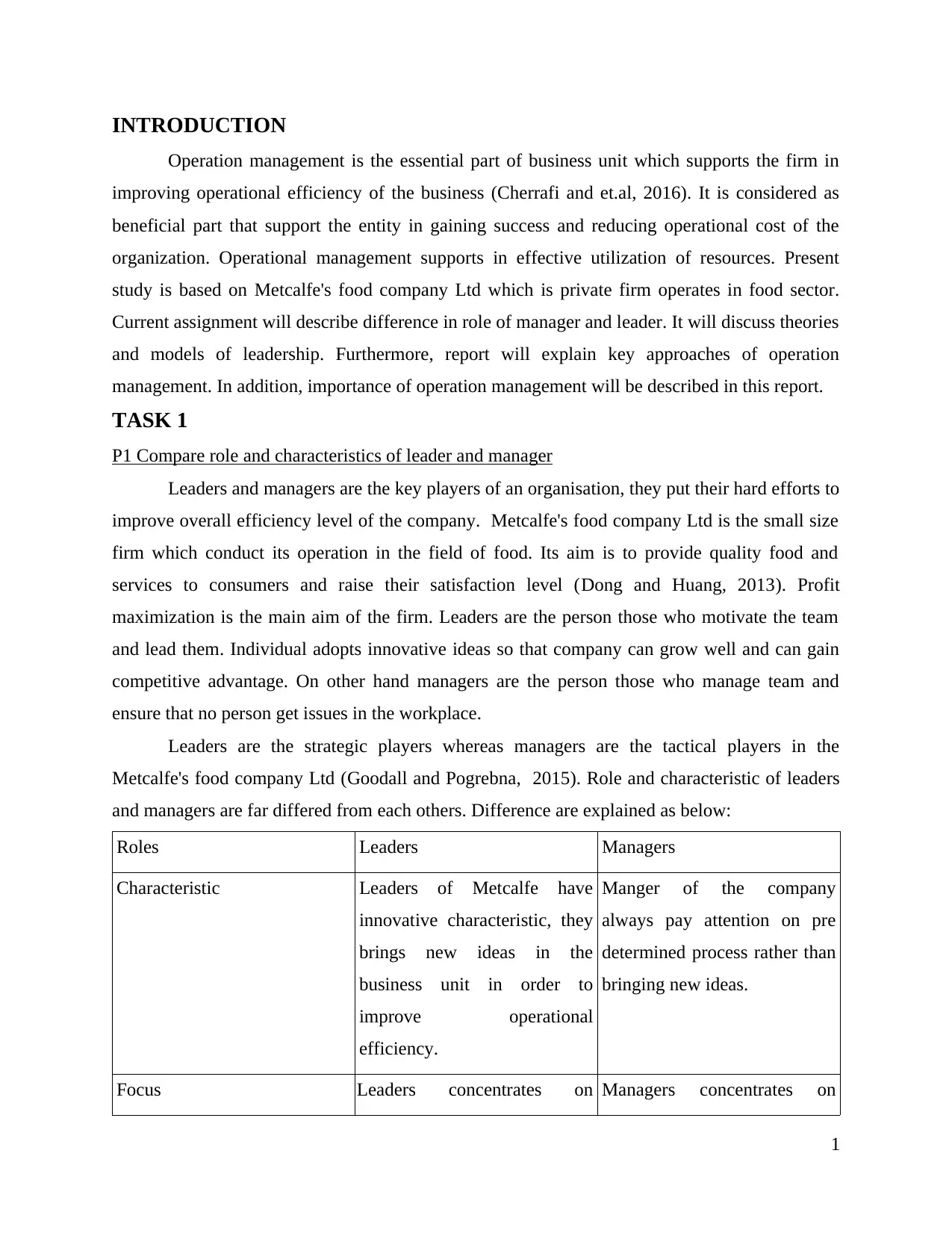
INTRODUCTION
Operation management is the essential part of business unit which supports the firm in
improving operational efficiency of the business (Cherrafi and et.al, 2016). It is considered as
beneficial part that support the entity in gaining success and reducing operational cost of the
organization. Operational management supports in effective utilization of resources. Present
study is based on Metcalfe's food company Ltd which is private firm operates in food sector.
Current assignment will describe difference in role of manager and leader. It will discuss theories
and models of leadership. Furthermore, report will explain key approaches of operation
management. In addition, importance of operation management will be described in this report.
TASK 1
P1 Compare role and characteristics of leader and manager
Leaders and managers are the key players of an organisation, they put their hard efforts to
improve overall efficiency level of the company. Metcalfe's food company Ltd is the small size
firm which conduct its operation in the field of food. Its aim is to provide quality food and
services to consumers and raise their satisfaction level (Dong and Huang, 2013). Profit
maximization is the main aim of the firm. Leaders are the person those who motivate the team
and lead them. Individual adopts innovative ideas so that company can grow well and can gain
competitive advantage. On other hand managers are the person those who manage team and
ensure that no person get issues in the workplace.
Leaders are the strategic players whereas managers are the tactical players in the
Metcalfe's food company Ltd (Goodall and Pogrebna, 2015). Role and characteristic of leaders
and managers are far differed from each others. Difference are explained as below:
Roles Leaders Managers
Characteristic Leaders of Metcalfe have
innovative characteristic, they
brings new ideas in the
business unit in order to
improve operational
efficiency.
Manger of the company
always pay attention on pre
determined process rather than
bringing new ideas.
Focus Leaders concentrates on Managers concentrates on
1
Operation management is the essential part of business unit which supports the firm in
improving operational efficiency of the business (Cherrafi and et.al, 2016). It is considered as
beneficial part that support the entity in gaining success and reducing operational cost of the
organization. Operational management supports in effective utilization of resources. Present
study is based on Metcalfe's food company Ltd which is private firm operates in food sector.
Current assignment will describe difference in role of manager and leader. It will discuss theories
and models of leadership. Furthermore, report will explain key approaches of operation
management. In addition, importance of operation management will be described in this report.
TASK 1
P1 Compare role and characteristics of leader and manager
Leaders and managers are the key players of an organisation, they put their hard efforts to
improve overall efficiency level of the company. Metcalfe's food company Ltd is the small size
firm which conduct its operation in the field of food. Its aim is to provide quality food and
services to consumers and raise their satisfaction level (Dong and Huang, 2013). Profit
maximization is the main aim of the firm. Leaders are the person those who motivate the team
and lead them. Individual adopts innovative ideas so that company can grow well and can gain
competitive advantage. On other hand managers are the person those who manage team and
ensure that no person get issues in the workplace.
Leaders are the strategic players whereas managers are the tactical players in the
Metcalfe's food company Ltd (Goodall and Pogrebna, 2015). Role and characteristic of leaders
and managers are far differed from each others. Difference are explained as below:
Roles Leaders Managers
Characteristic Leaders of Metcalfe have
innovative characteristic, they
brings new ideas in the
business unit in order to
improve operational
efficiency.
Manger of the company
always pay attention on pre
determined process rather than
bringing new ideas.
Focus Leaders concentrates on Managers concentrates on
1
⊘ This is a preview!⊘
Do you want full access?
Subscribe today to unlock all pages.

Trusted by 1+ million students worldwide
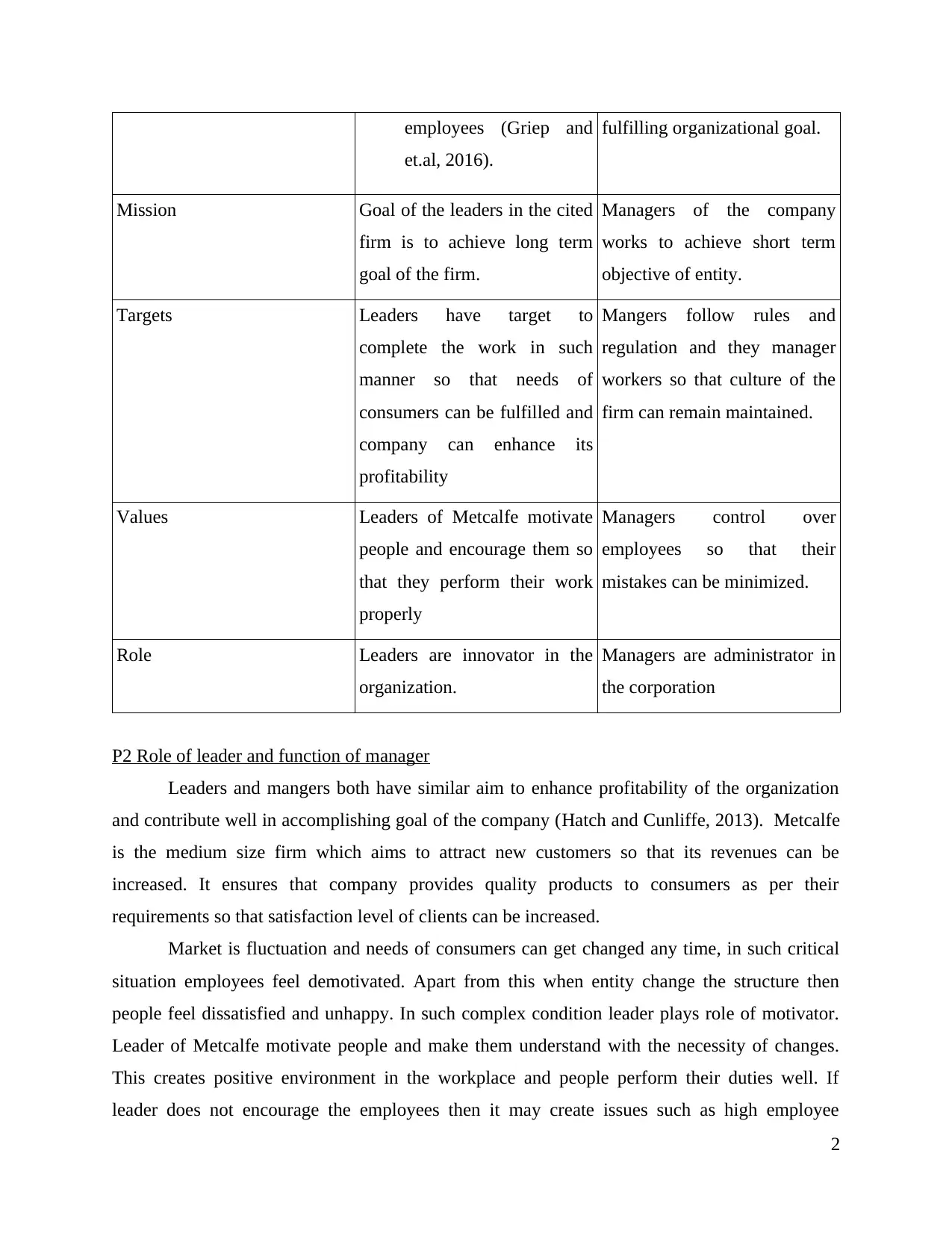
employees (Griep and
et.al, 2016).
fulfilling organizational goal.
Mission Goal of the leaders in the cited
firm is to achieve long term
goal of the firm.
Managers of the company
works to achieve short term
objective of entity.
Targets Leaders have target to
complete the work in such
manner so that needs of
consumers can be fulfilled and
company can enhance its
profitability
Mangers follow rules and
regulation and they manager
workers so that culture of the
firm can remain maintained.
Values Leaders of Metcalfe motivate
people and encourage them so
that they perform their work
properly
Managers control over
employees so that their
mistakes can be minimized.
Role Leaders are innovator in the
organization.
Managers are administrator in
the corporation
P2 Role of leader and function of manager
Leaders and mangers both have similar aim to enhance profitability of the organization
and contribute well in accomplishing goal of the company (Hatch and Cunliffe, 2013). Metcalfe
is the medium size firm which aims to attract new customers so that its revenues can be
increased. It ensures that company provides quality products to consumers as per their
requirements so that satisfaction level of clients can be increased.
Market is fluctuation and needs of consumers can get changed any time, in such critical
situation employees feel demotivated. Apart from this when entity change the structure then
people feel dissatisfied and unhappy. In such complex condition leader plays role of motivator.
Leader of Metcalfe motivate people and make them understand with the necessity of changes.
This creates positive environment in the workplace and people perform their duties well. If
leader does not encourage the employees then it may create issues such as high employee
2
et.al, 2016).
fulfilling organizational goal.
Mission Goal of the leaders in the cited
firm is to achieve long term
goal of the firm.
Managers of the company
works to achieve short term
objective of entity.
Targets Leaders have target to
complete the work in such
manner so that needs of
consumers can be fulfilled and
company can enhance its
profitability
Mangers follow rules and
regulation and they manager
workers so that culture of the
firm can remain maintained.
Values Leaders of Metcalfe motivate
people and encourage them so
that they perform their work
properly
Managers control over
employees so that their
mistakes can be minimized.
Role Leaders are innovator in the
organization.
Managers are administrator in
the corporation
P2 Role of leader and function of manager
Leaders and mangers both have similar aim to enhance profitability of the organization
and contribute well in accomplishing goal of the company (Hatch and Cunliffe, 2013). Metcalfe
is the medium size firm which aims to attract new customers so that its revenues can be
increased. It ensures that company provides quality products to consumers as per their
requirements so that satisfaction level of clients can be increased.
Market is fluctuation and needs of consumers can get changed any time, in such critical
situation employees feel demotivated. Apart from this when entity change the structure then
people feel dissatisfied and unhappy. In such complex condition leader plays role of motivator.
Leader of Metcalfe motivate people and make them understand with the necessity of changes.
This creates positive environment in the workplace and people perform their duties well. If
leader does not encourage the employees then it may create issues such as high employee
2
Paraphrase This Document
Need a fresh take? Get an instant paraphrase of this document with our AI Paraphraser
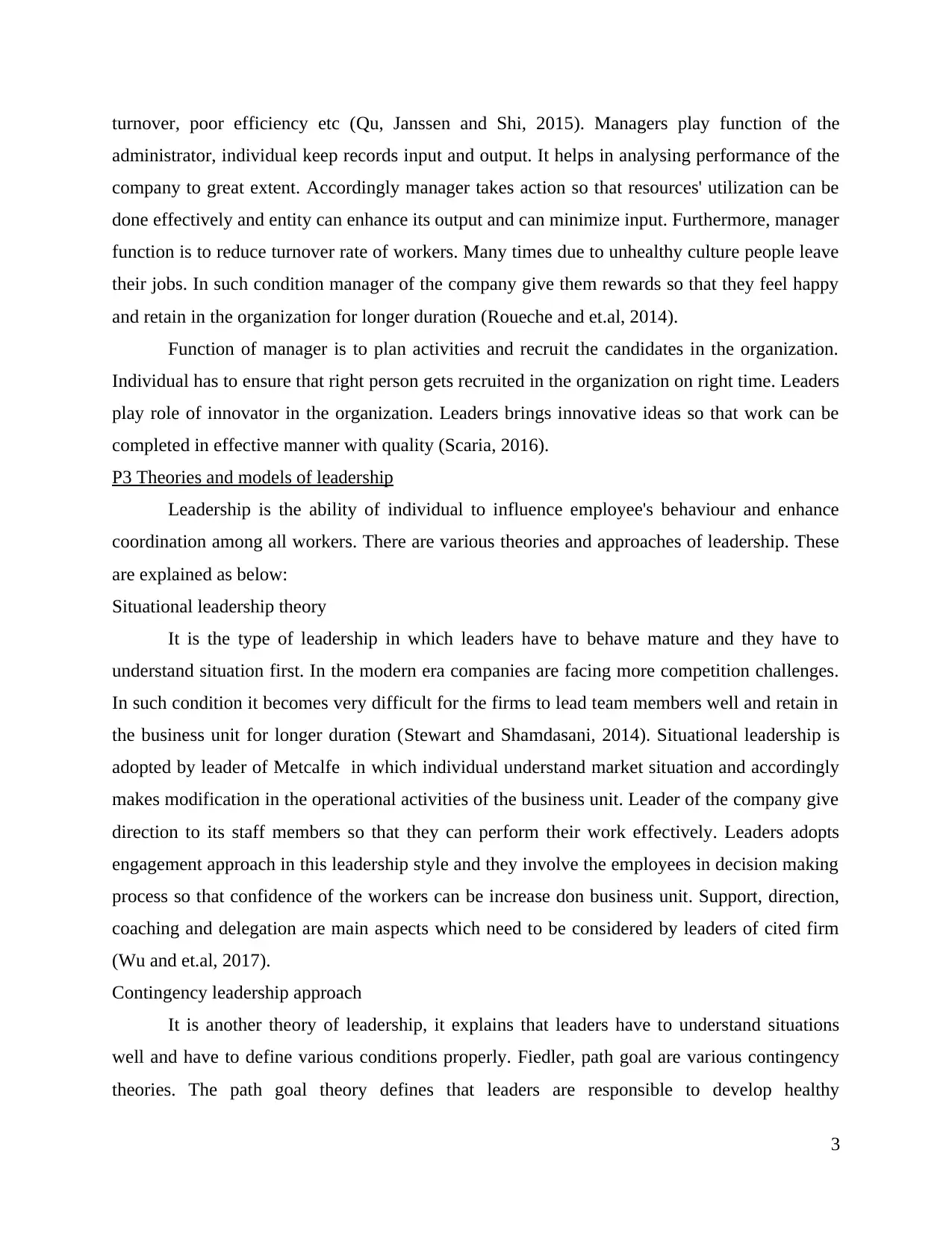
turnover, poor efficiency etc (Qu, Janssen and Shi, 2015). Managers play function of the
administrator, individual keep records input and output. It helps in analysing performance of the
company to great extent. Accordingly manager takes action so that resources' utilization can be
done effectively and entity can enhance its output and can minimize input. Furthermore, manager
function is to reduce turnover rate of workers. Many times due to unhealthy culture people leave
their jobs. In such condition manager of the company give them rewards so that they feel happy
and retain in the organization for longer duration (Roueche and et.al, 2014).
Function of manager is to plan activities and recruit the candidates in the organization.
Individual has to ensure that right person gets recruited in the organization on right time. Leaders
play role of innovator in the organization. Leaders brings innovative ideas so that work can be
completed in effective manner with quality (Scaria, 2016).
P3 Theories and models of leadership
Leadership is the ability of individual to influence employee's behaviour and enhance
coordination among all workers. There are various theories and approaches of leadership. These
are explained as below:
Situational leadership theory
It is the type of leadership in which leaders have to behave mature and they have to
understand situation first. In the modern era companies are facing more competition challenges.
In such condition it becomes very difficult for the firms to lead team members well and retain in
the business unit for longer duration (Stewart and Shamdasani, 2014). Situational leadership is
adopted by leader of Metcalfe in which individual understand market situation and accordingly
makes modification in the operational activities of the business unit. Leader of the company give
direction to its staff members so that they can perform their work effectively. Leaders adopts
engagement approach in this leadership style and they involve the employees in decision making
process so that confidence of the workers can be increase don business unit. Support, direction,
coaching and delegation are main aspects which need to be considered by leaders of cited firm
(Wu and et.al, 2017).
Contingency leadership approach
It is another theory of leadership, it explains that leaders have to understand situations
well and have to define various conditions properly. Fiedler, path goal are various contingency
theories. The path goal theory defines that leaders are responsible to develop healthy
3
administrator, individual keep records input and output. It helps in analysing performance of the
company to great extent. Accordingly manager takes action so that resources' utilization can be
done effectively and entity can enhance its output and can minimize input. Furthermore, manager
function is to reduce turnover rate of workers. Many times due to unhealthy culture people leave
their jobs. In such condition manager of the company give them rewards so that they feel happy
and retain in the organization for longer duration (Roueche and et.al, 2014).
Function of manager is to plan activities and recruit the candidates in the organization.
Individual has to ensure that right person gets recruited in the organization on right time. Leaders
play role of innovator in the organization. Leaders brings innovative ideas so that work can be
completed in effective manner with quality (Scaria, 2016).
P3 Theories and models of leadership
Leadership is the ability of individual to influence employee's behaviour and enhance
coordination among all workers. There are various theories and approaches of leadership. These
are explained as below:
Situational leadership theory
It is the type of leadership in which leaders have to behave mature and they have to
understand situation first. In the modern era companies are facing more competition challenges.
In such condition it becomes very difficult for the firms to lead team members well and retain in
the business unit for longer duration (Stewart and Shamdasani, 2014). Situational leadership is
adopted by leader of Metcalfe in which individual understand market situation and accordingly
makes modification in the operational activities of the business unit. Leader of the company give
direction to its staff members so that they can perform their work effectively. Leaders adopts
engagement approach in this leadership style and they involve the employees in decision making
process so that confidence of the workers can be increase don business unit. Support, direction,
coaching and delegation are main aspects which need to be considered by leaders of cited firm
(Wu and et.al, 2017).
Contingency leadership approach
It is another theory of leadership, it explains that leaders have to understand situations
well and have to define various conditions properly. Fiedler, path goal are various contingency
theories. The path goal theory defines that leaders are responsible to develop healthy
3
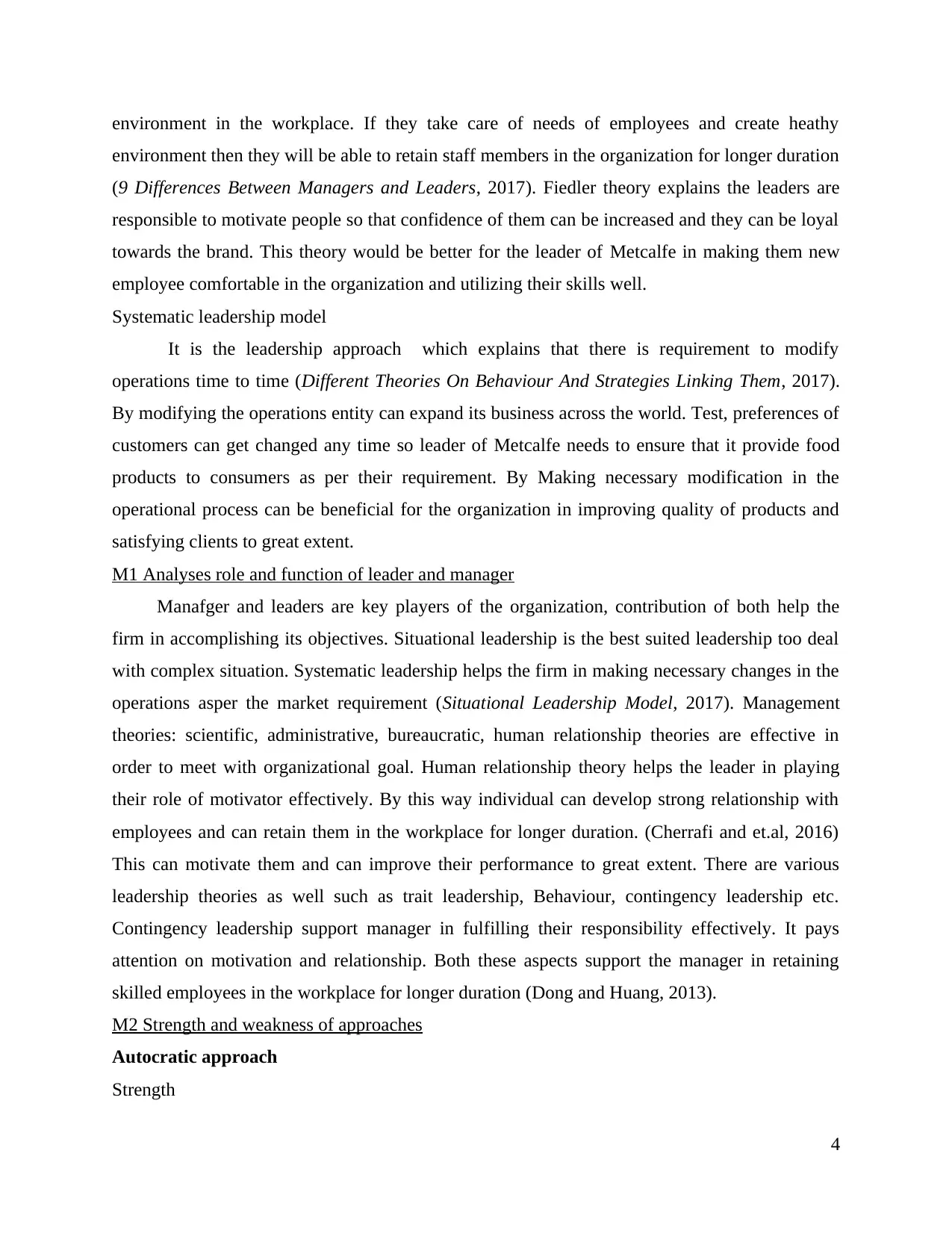
environment in the workplace. If they take care of needs of employees and create heathy
environment then they will be able to retain staff members in the organization for longer duration
(9 Differences Between Managers and Leaders, 2017). Fiedler theory explains the leaders are
responsible to motivate people so that confidence of them can be increased and they can be loyal
towards the brand. This theory would be better for the leader of Metcalfe in making them new
employee comfortable in the organization and utilizing their skills well.
Systematic leadership model
It is the leadership approach which explains that there is requirement to modify
operations time to time (Different Theories On Behaviour And Strategies Linking Them, 2017).
By modifying the operations entity can expand its business across the world. Test, preferences of
customers can get changed any time so leader of Metcalfe needs to ensure that it provide food
products to consumers as per their requirement. By Making necessary modification in the
operational process can be beneficial for the organization in improving quality of products and
satisfying clients to great extent.
M1 Analyses role and function of leader and manager
Manafger and leaders are key players of the organization, contribution of both help the
firm in accomplishing its objectives. Situational leadership is the best suited leadership too deal
with complex situation. Systematic leadership helps the firm in making necessary changes in the
operations asper the market requirement (Situational Leadership Model, 2017). Management
theories: scientific, administrative, bureaucratic, human relationship theories are effective in
order to meet with organizational goal. Human relationship theory helps the leader in playing
their role of motivator effectively. By this way individual can develop strong relationship with
employees and can retain them in the workplace for longer duration. (Cherrafi and et.al, 2016)
This can motivate them and can improve their performance to great extent. There are various
leadership theories as well such as trait leadership, Behaviour, contingency leadership etc.
Contingency leadership support manager in fulfilling their responsibility effectively. It pays
attention on motivation and relationship. Both these aspects support the manager in retaining
skilled employees in the workplace for longer duration (Dong and Huang, 2013).
M2 Strength and weakness of approaches
Autocratic approach
Strength
4
environment then they will be able to retain staff members in the organization for longer duration
(9 Differences Between Managers and Leaders, 2017). Fiedler theory explains the leaders are
responsible to motivate people so that confidence of them can be increased and they can be loyal
towards the brand. This theory would be better for the leader of Metcalfe in making them new
employee comfortable in the organization and utilizing their skills well.
Systematic leadership model
It is the leadership approach which explains that there is requirement to modify
operations time to time (Different Theories On Behaviour And Strategies Linking Them, 2017).
By modifying the operations entity can expand its business across the world. Test, preferences of
customers can get changed any time so leader of Metcalfe needs to ensure that it provide food
products to consumers as per their requirement. By Making necessary modification in the
operational process can be beneficial for the organization in improving quality of products and
satisfying clients to great extent.
M1 Analyses role and function of leader and manager
Manafger and leaders are key players of the organization, contribution of both help the
firm in accomplishing its objectives. Situational leadership is the best suited leadership too deal
with complex situation. Systematic leadership helps the firm in making necessary changes in the
operations asper the market requirement (Situational Leadership Model, 2017). Management
theories: scientific, administrative, bureaucratic, human relationship theories are effective in
order to meet with organizational goal. Human relationship theory helps the leader in playing
their role of motivator effectively. By this way individual can develop strong relationship with
employees and can retain them in the workplace for longer duration. (Cherrafi and et.al, 2016)
This can motivate them and can improve their performance to great extent. There are various
leadership theories as well such as trait leadership, Behaviour, contingency leadership etc.
Contingency leadership support manager in fulfilling their responsibility effectively. It pays
attention on motivation and relationship. Both these aspects support the manager in retaining
skilled employees in the workplace for longer duration (Dong and Huang, 2013).
M2 Strength and weakness of approaches
Autocratic approach
Strength
4
⊘ This is a preview!⊘
Do you want full access?
Subscribe today to unlock all pages.

Trusted by 1+ million students worldwide
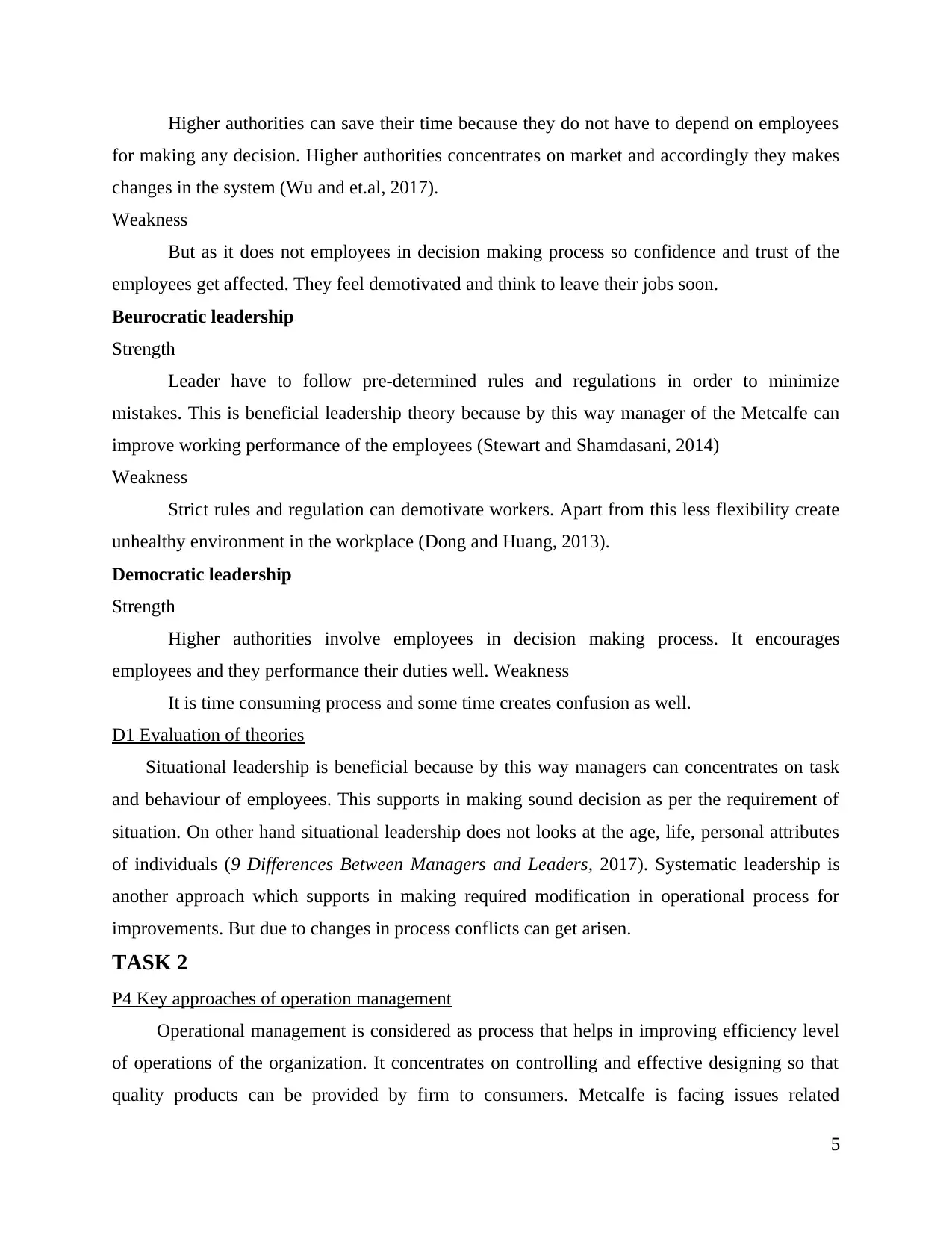
Higher authorities can save their time because they do not have to depend on employees
for making any decision. Higher authorities concentrates on market and accordingly they makes
changes in the system (Wu and et.al, 2017).
Weakness
But as it does not employees in decision making process so confidence and trust of the
employees get affected. They feel demotivated and think to leave their jobs soon.
Beurocratic leadership
Strength
Leader have to follow pre-determined rules and regulations in order to minimize
mistakes. This is beneficial leadership theory because by this way manager of the Metcalfe can
improve working performance of the employees (Stewart and Shamdasani, 2014)
Weakness
Strict rules and regulation can demotivate workers. Apart from this less flexibility create
unhealthy environment in the workplace (Dong and Huang, 2013).
Democratic leadership
Strength
Higher authorities involve employees in decision making process. It encourages
employees and they performance their duties well. Weakness
It is time consuming process and some time creates confusion as well.
D1 Evaluation of theories
Situational leadership is beneficial because by this way managers can concentrates on task
and behaviour of employees. This supports in making sound decision as per the requirement of
situation. On other hand situational leadership does not looks at the age, life, personal attributes
of individuals (9 Differences Between Managers and Leaders, 2017). Systematic leadership is
another approach which supports in making required modification in operational process for
improvements. But due to changes in process conflicts can get arisen.
TASK 2
P4 Key approaches of operation management
Operational management is considered as process that helps in improving efficiency level
of operations of the organization. It concentrates on controlling and effective designing so that
quality products can be provided by firm to consumers. Metcalfe is facing issues related
5
for making any decision. Higher authorities concentrates on market and accordingly they makes
changes in the system (Wu and et.al, 2017).
Weakness
But as it does not employees in decision making process so confidence and trust of the
employees get affected. They feel demotivated and think to leave their jobs soon.
Beurocratic leadership
Strength
Leader have to follow pre-determined rules and regulations in order to minimize
mistakes. This is beneficial leadership theory because by this way manager of the Metcalfe can
improve working performance of the employees (Stewart and Shamdasani, 2014)
Weakness
Strict rules and regulation can demotivate workers. Apart from this less flexibility create
unhealthy environment in the workplace (Dong and Huang, 2013).
Democratic leadership
Strength
Higher authorities involve employees in decision making process. It encourages
employees and they performance their duties well. Weakness
It is time consuming process and some time creates confusion as well.
D1 Evaluation of theories
Situational leadership is beneficial because by this way managers can concentrates on task
and behaviour of employees. This supports in making sound decision as per the requirement of
situation. On other hand situational leadership does not looks at the age, life, personal attributes
of individuals (9 Differences Between Managers and Leaders, 2017). Systematic leadership is
another approach which supports in making required modification in operational process for
improvements. But due to changes in process conflicts can get arisen.
TASK 2
P4 Key approaches of operation management
Operational management is considered as process that helps in improving efficiency level
of operations of the organization. It concentrates on controlling and effective designing so that
quality products can be provided by firm to consumers. Metcalfe is facing issues related
5
Paraphrase This Document
Need a fresh take? Get an instant paraphrase of this document with our AI Paraphraser
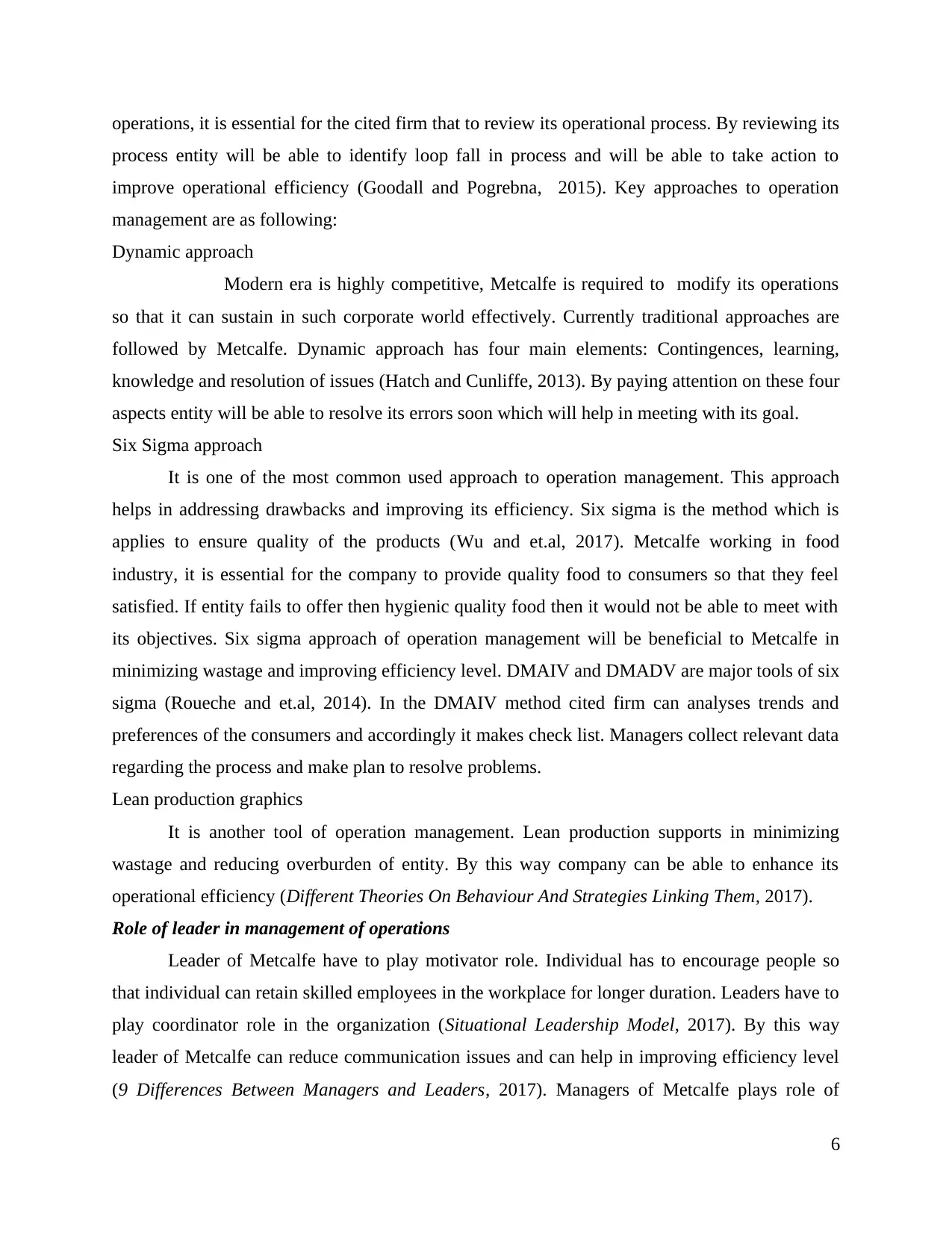
operations, it is essential for the cited firm that to review its operational process. By reviewing its
process entity will be able to identify loop fall in process and will be able to take action to
improve operational efficiency (Goodall and Pogrebna, 2015). Key approaches to operation
management are as following:
Dynamic approach
Modern era is highly competitive, Metcalfe is required to modify its operations
so that it can sustain in such corporate world effectively. Currently traditional approaches are
followed by Metcalfe. Dynamic approach has four main elements: Contingences, learning,
knowledge and resolution of issues (Hatch and Cunliffe, 2013). By paying attention on these four
aspects entity will be able to resolve its errors soon which will help in meeting with its goal.
Six Sigma approach
It is one of the most common used approach to operation management. This approach
helps in addressing drawbacks and improving its efficiency. Six sigma is the method which is
applies to ensure quality of the products (Wu and et.al, 2017). Metcalfe working in food
industry, it is essential for the company to provide quality food to consumers so that they feel
satisfied. If entity fails to offer then hygienic quality food then it would not be able to meet with
its objectives. Six sigma approach of operation management will be beneficial to Metcalfe in
minimizing wastage and improving efficiency level. DMAIV and DMADV are major tools of six
sigma (Roueche and et.al, 2014). In the DMAIV method cited firm can analyses trends and
preferences of the consumers and accordingly it makes check list. Managers collect relevant data
regarding the process and make plan to resolve problems.
Lean production graphics
It is another tool of operation management. Lean production supports in minimizing
wastage and reducing overburden of entity. By this way company can be able to enhance its
operational efficiency (Different Theories On Behaviour And Strategies Linking Them, 2017).
Role of leader in management of operations
Leader of Metcalfe have to play motivator role. Individual has to encourage people so
that individual can retain skilled employees in the workplace for longer duration. Leaders have to
play coordinator role in the organization (Situational Leadership Model, 2017). By this way
leader of Metcalfe can reduce communication issues and can help in improving efficiency level
(9 Differences Between Managers and Leaders, 2017). Managers of Metcalfe plays role of
6
process entity will be able to identify loop fall in process and will be able to take action to
improve operational efficiency (Goodall and Pogrebna, 2015). Key approaches to operation
management are as following:
Dynamic approach
Modern era is highly competitive, Metcalfe is required to modify its operations
so that it can sustain in such corporate world effectively. Currently traditional approaches are
followed by Metcalfe. Dynamic approach has four main elements: Contingences, learning,
knowledge and resolution of issues (Hatch and Cunliffe, 2013). By paying attention on these four
aspects entity will be able to resolve its errors soon which will help in meeting with its goal.
Six Sigma approach
It is one of the most common used approach to operation management. This approach
helps in addressing drawbacks and improving its efficiency. Six sigma is the method which is
applies to ensure quality of the products (Wu and et.al, 2017). Metcalfe working in food
industry, it is essential for the company to provide quality food to consumers so that they feel
satisfied. If entity fails to offer then hygienic quality food then it would not be able to meet with
its objectives. Six sigma approach of operation management will be beneficial to Metcalfe in
minimizing wastage and improving efficiency level. DMAIV and DMADV are major tools of six
sigma (Roueche and et.al, 2014). In the DMAIV method cited firm can analyses trends and
preferences of the consumers and accordingly it makes check list. Managers collect relevant data
regarding the process and make plan to resolve problems.
Lean production graphics
It is another tool of operation management. Lean production supports in minimizing
wastage and reducing overburden of entity. By this way company can be able to enhance its
operational efficiency (Different Theories On Behaviour And Strategies Linking Them, 2017).
Role of leader in management of operations
Leader of Metcalfe have to play motivator role. Individual has to encourage people so
that individual can retain skilled employees in the workplace for longer duration. Leaders have to
play coordinator role in the organization (Situational Leadership Model, 2017). By this way
leader of Metcalfe can reduce communication issues and can help in improving efficiency level
(9 Differences Between Managers and Leaders, 2017). Managers of Metcalfe plays role of
6
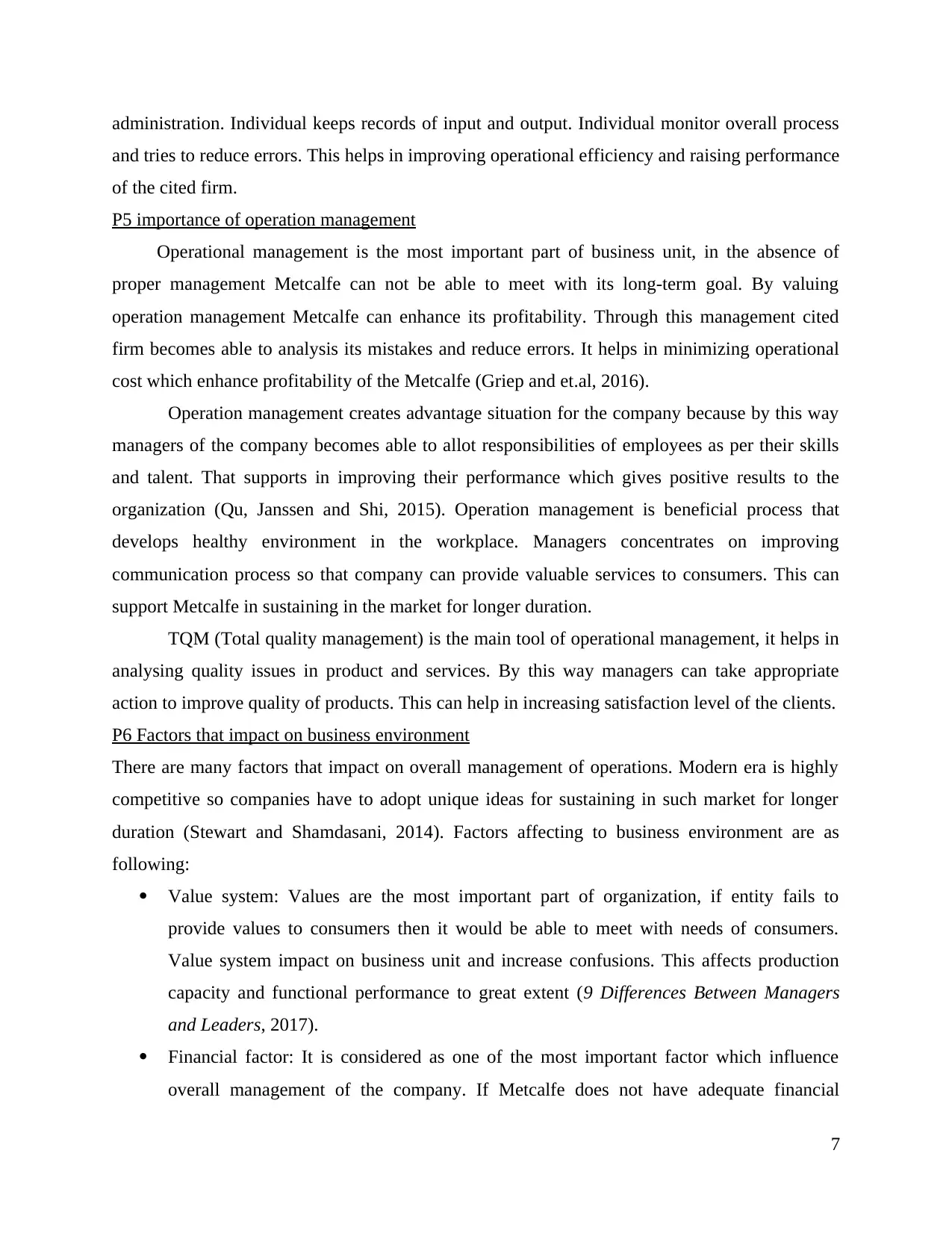
administration. Individual keeps records of input and output. Individual monitor overall process
and tries to reduce errors. This helps in improving operational efficiency and raising performance
of the cited firm.
P5 importance of operation management
Operational management is the most important part of business unit, in the absence of
proper management Metcalfe can not be able to meet with its long-term goal. By valuing
operation management Metcalfe can enhance its profitability. Through this management cited
firm becomes able to analysis its mistakes and reduce errors. It helps in minimizing operational
cost which enhance profitability of the Metcalfe (Griep and et.al, 2016).
Operation management creates advantage situation for the company because by this way
managers of the company becomes able to allot responsibilities of employees as per their skills
and talent. That supports in improving their performance which gives positive results to the
organization (Qu, Janssen and Shi, 2015). Operation management is beneficial process that
develops healthy environment in the workplace. Managers concentrates on improving
communication process so that company can provide valuable services to consumers. This can
support Metcalfe in sustaining in the market for longer duration.
TQM (Total quality management) is the main tool of operational management, it helps in
analysing quality issues in product and services. By this way managers can take appropriate
action to improve quality of products. This can help in increasing satisfaction level of the clients.
P6 Factors that impact on business environment
There are many factors that impact on overall management of operations. Modern era is highly
competitive so companies have to adopt unique ideas for sustaining in such market for longer
duration (Stewart and Shamdasani, 2014). Factors affecting to business environment are as
following:
Value system: Values are the most important part of organization, if entity fails to
provide values to consumers then it would be able to meet with needs of consumers.
Value system impact on business unit and increase confusions. This affects production
capacity and functional performance to great extent (9 Differences Between Managers
and Leaders, 2017).
Financial factor: It is considered as one of the most important factor which influence
overall management of the company. If Metcalfe does not have adequate financial
7
and tries to reduce errors. This helps in improving operational efficiency and raising performance
of the cited firm.
P5 importance of operation management
Operational management is the most important part of business unit, in the absence of
proper management Metcalfe can not be able to meet with its long-term goal. By valuing
operation management Metcalfe can enhance its profitability. Through this management cited
firm becomes able to analysis its mistakes and reduce errors. It helps in minimizing operational
cost which enhance profitability of the Metcalfe (Griep and et.al, 2016).
Operation management creates advantage situation for the company because by this way
managers of the company becomes able to allot responsibilities of employees as per their skills
and talent. That supports in improving their performance which gives positive results to the
organization (Qu, Janssen and Shi, 2015). Operation management is beneficial process that
develops healthy environment in the workplace. Managers concentrates on improving
communication process so that company can provide valuable services to consumers. This can
support Metcalfe in sustaining in the market for longer duration.
TQM (Total quality management) is the main tool of operational management, it helps in
analysing quality issues in product and services. By this way managers can take appropriate
action to improve quality of products. This can help in increasing satisfaction level of the clients.
P6 Factors that impact on business environment
There are many factors that impact on overall management of operations. Modern era is highly
competitive so companies have to adopt unique ideas for sustaining in such market for longer
duration (Stewart and Shamdasani, 2014). Factors affecting to business environment are as
following:
Value system: Values are the most important part of organization, if entity fails to
provide values to consumers then it would be able to meet with needs of consumers.
Value system impact on business unit and increase confusions. This affects production
capacity and functional performance to great extent (9 Differences Between Managers
and Leaders, 2017).
Financial factor: It is considered as one of the most important factor which influence
overall management of the company. If Metcalfe does not have adequate financial
7
⊘ This is a preview!⊘
Do you want full access?
Subscribe today to unlock all pages.

Trusted by 1+ million students worldwide
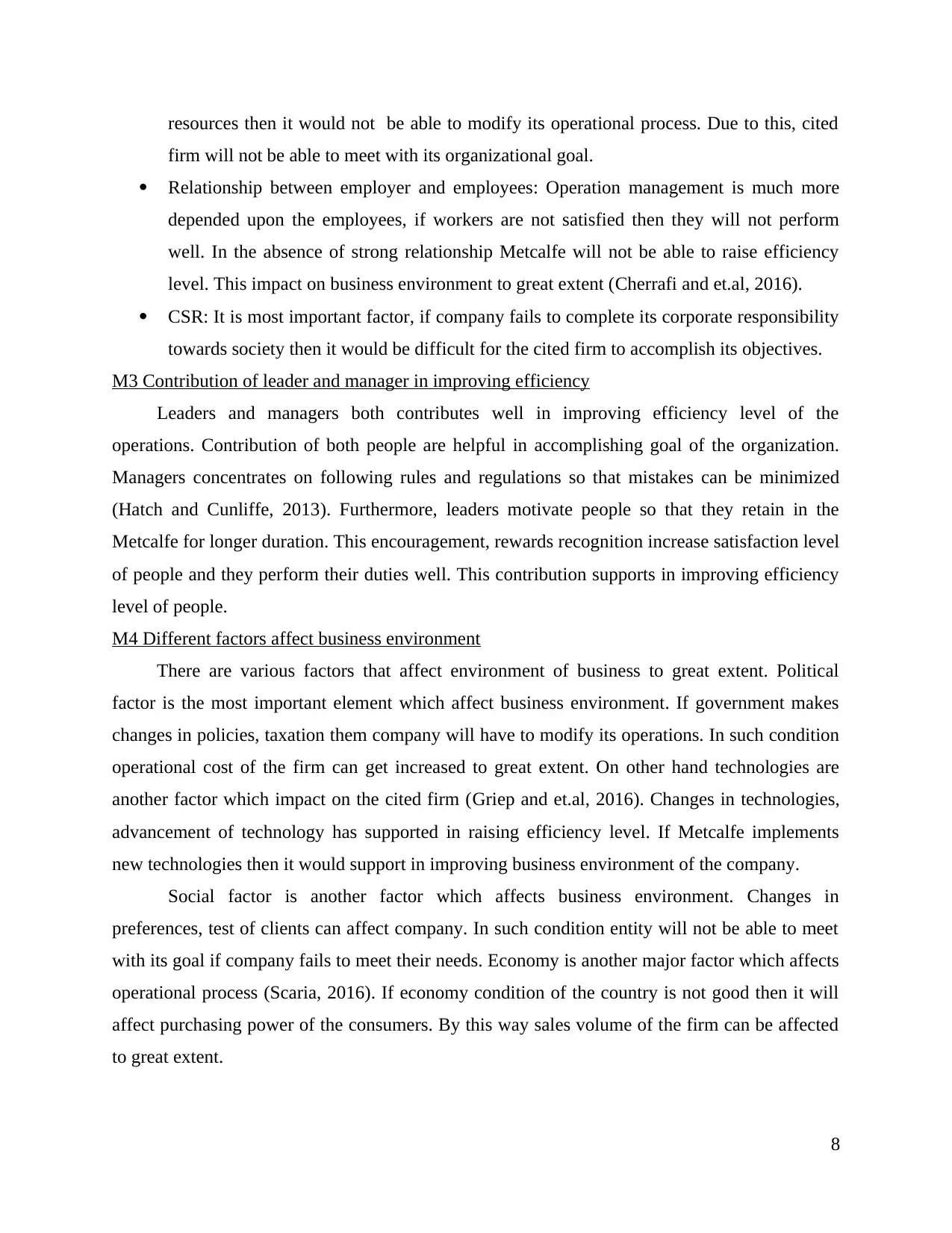
resources then it would not be able to modify its operational process. Due to this, cited
firm will not be able to meet with its organizational goal.
Relationship between employer and employees: Operation management is much more
depended upon the employees, if workers are not satisfied then they will not perform
well. In the absence of strong relationship Metcalfe will not be able to raise efficiency
level. This impact on business environment to great extent (Cherrafi and et.al, 2016).
CSR: It is most important factor, if company fails to complete its corporate responsibility
towards society then it would be difficult for the cited firm to accomplish its objectives.
M3 Contribution of leader and manager in improving efficiency
Leaders and managers both contributes well in improving efficiency level of the
operations. Contribution of both people are helpful in accomplishing goal of the organization.
Managers concentrates on following rules and regulations so that mistakes can be minimized
(Hatch and Cunliffe, 2013). Furthermore, leaders motivate people so that they retain in the
Metcalfe for longer duration. This encouragement, rewards recognition increase satisfaction level
of people and they perform their duties well. This contribution supports in improving efficiency
level of people.
M4 Different factors affect business environment
There are various factors that affect environment of business to great extent. Political
factor is the most important element which affect business environment. If government makes
changes in policies, taxation them company will have to modify its operations. In such condition
operational cost of the firm can get increased to great extent. On other hand technologies are
another factor which impact on the cited firm (Griep and et.al, 2016). Changes in technologies,
advancement of technology has supported in raising efficiency level. If Metcalfe implements
new technologies then it would support in improving business environment of the company.
Social factor is another factor which affects business environment. Changes in
preferences, test of clients can affect company. In such condition entity will not be able to meet
with its goal if company fails to meet their needs. Economy is another major factor which affects
operational process (Scaria, 2016). If economy condition of the country is not good then it will
affect purchasing power of the consumers. By this way sales volume of the firm can be affected
to great extent.
8
firm will not be able to meet with its organizational goal.
Relationship between employer and employees: Operation management is much more
depended upon the employees, if workers are not satisfied then they will not perform
well. In the absence of strong relationship Metcalfe will not be able to raise efficiency
level. This impact on business environment to great extent (Cherrafi and et.al, 2016).
CSR: It is most important factor, if company fails to complete its corporate responsibility
towards society then it would be difficult for the cited firm to accomplish its objectives.
M3 Contribution of leader and manager in improving efficiency
Leaders and managers both contributes well in improving efficiency level of the
operations. Contribution of both people are helpful in accomplishing goal of the organization.
Managers concentrates on following rules and regulations so that mistakes can be minimized
(Hatch and Cunliffe, 2013). Furthermore, leaders motivate people so that they retain in the
Metcalfe for longer duration. This encouragement, rewards recognition increase satisfaction level
of people and they perform their duties well. This contribution supports in improving efficiency
level of people.
M4 Different factors affect business environment
There are various factors that affect environment of business to great extent. Political
factor is the most important element which affect business environment. If government makes
changes in policies, taxation them company will have to modify its operations. In such condition
operational cost of the firm can get increased to great extent. On other hand technologies are
another factor which impact on the cited firm (Griep and et.al, 2016). Changes in technologies,
advancement of technology has supported in raising efficiency level. If Metcalfe implements
new technologies then it would support in improving business environment of the company.
Social factor is another factor which affects business environment. Changes in
preferences, test of clients can affect company. In such condition entity will not be able to meet
with its goal if company fails to meet their needs. Economy is another major factor which affects
operational process (Scaria, 2016). If economy condition of the country is not good then it will
affect purchasing power of the consumers. By this way sales volume of the firm can be affected
to great extent.
8
Paraphrase This Document
Need a fresh take? Get an instant paraphrase of this document with our AI Paraphraser
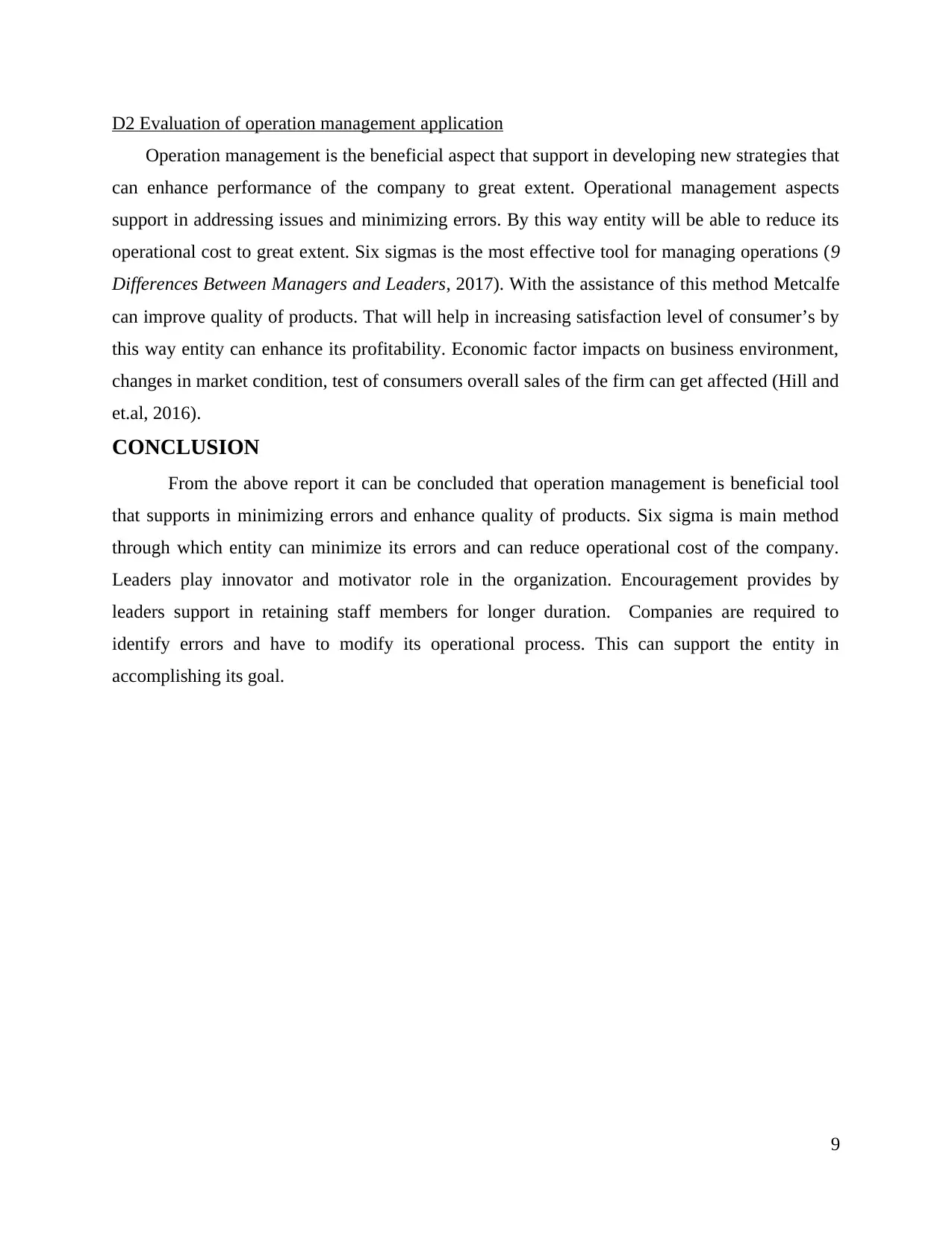
D2 Evaluation of operation management application
Operation management is the beneficial aspect that support in developing new strategies that
can enhance performance of the company to great extent. Operational management aspects
support in addressing issues and minimizing errors. By this way entity will be able to reduce its
operational cost to great extent. Six sigmas is the most effective tool for managing operations (9
Differences Between Managers and Leaders, 2017). With the assistance of this method Metcalfe
can improve quality of products. That will help in increasing satisfaction level of consumer’s by
this way entity can enhance its profitability. Economic factor impacts on business environment,
changes in market condition, test of consumers overall sales of the firm can get affected (Hill and
et.al, 2016).
CONCLUSION
From the above report it can be concluded that operation management is beneficial tool
that supports in minimizing errors and enhance quality of products. Six sigma is main method
through which entity can minimize its errors and can reduce operational cost of the company.
Leaders play innovator and motivator role in the organization. Encouragement provides by
leaders support in retaining staff members for longer duration. Companies are required to
identify errors and have to modify its operational process. This can support the entity in
accomplishing its goal.
9
Operation management is the beneficial aspect that support in developing new strategies that
can enhance performance of the company to great extent. Operational management aspects
support in addressing issues and minimizing errors. By this way entity will be able to reduce its
operational cost to great extent. Six sigmas is the most effective tool for managing operations (9
Differences Between Managers and Leaders, 2017). With the assistance of this method Metcalfe
can improve quality of products. That will help in increasing satisfaction level of consumer’s by
this way entity can enhance its profitability. Economic factor impacts on business environment,
changes in market condition, test of consumers overall sales of the firm can get affected (Hill and
et.al, 2016).
CONCLUSION
From the above report it can be concluded that operation management is beneficial tool
that supports in minimizing errors and enhance quality of products. Six sigma is main method
through which entity can minimize its errors and can reduce operational cost of the company.
Leaders play innovator and motivator role in the organization. Encouragement provides by
leaders support in retaining staff members for longer duration. Companies are required to
identify errors and have to modify its operational process. This can support the entity in
accomplishing its goal.
9
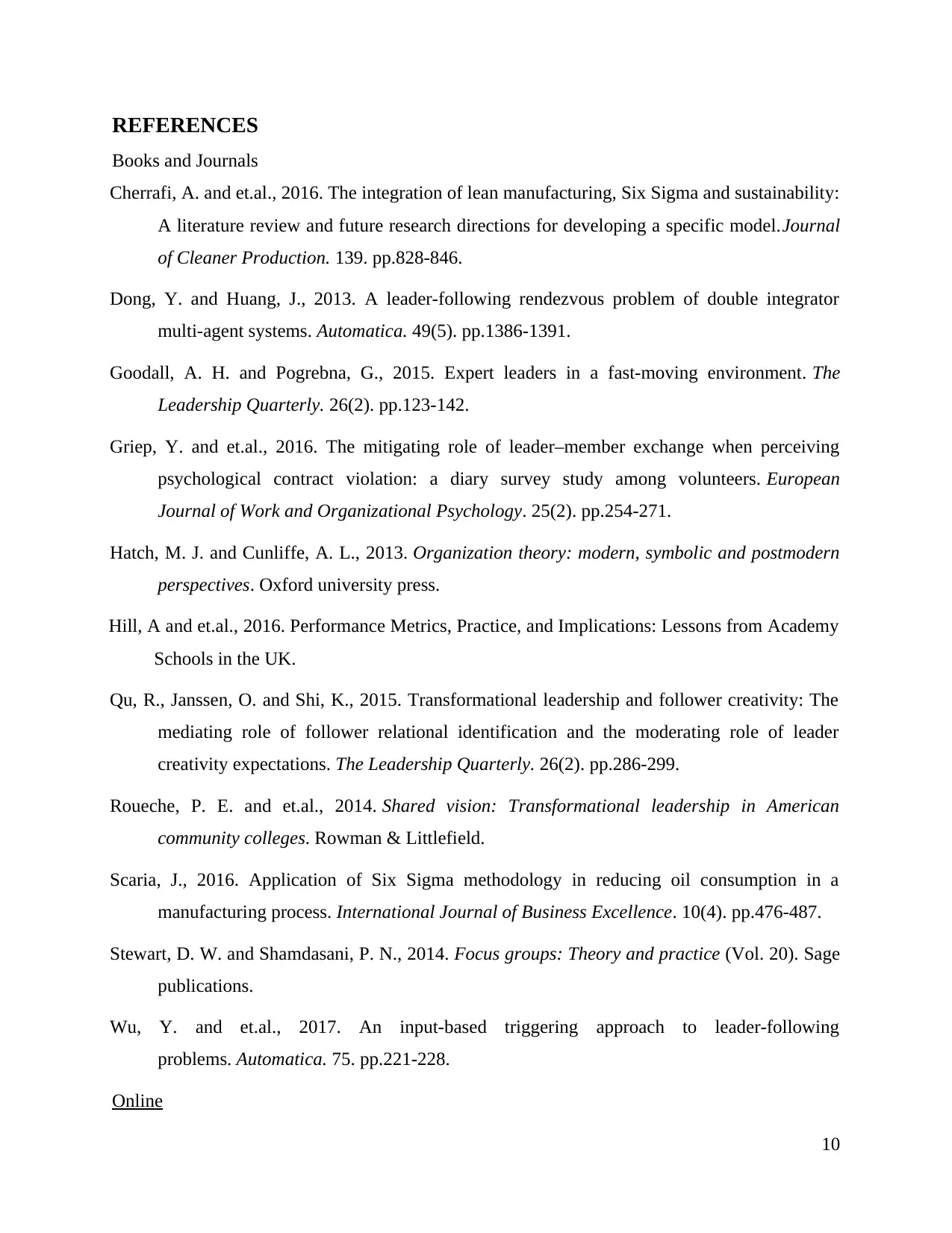
REFERENCES
Books and Journals
Cherrafi, A. and et.al., 2016. The integration of lean manufacturing, Six Sigma and sustainability:
A literature review and future research directions for developing a specific model.Journal
of Cleaner Production. 139. pp.828-846.
Dong, Y. and Huang, J., 2013. A leader-following rendezvous problem of double integrator
multi-agent systems. Automatica. 49(5). pp.1386-1391.
Goodall, A. H. and Pogrebna, G., 2015. Expert leaders in a fast-moving environment. The
Leadership Quarterly. 26(2). pp.123-142.
Griep, Y. and et.al., 2016. The mitigating role of leader‒member exchange when perceiving
psychological contract violation: a diary survey study among volunteers. European
Journal of Work and Organizational Psychology. 25(2). pp.254-271.
Hatch, M. J. and Cunliffe, A. L., 2013. Organization theory: modern, symbolic and postmodern
perspectives. Oxford university press.
Hill, A and et.al., 2016. Performance Metrics, Practice, and Implications: Lessons from Academy
Schools in the UK.
Qu, R., Janssen, O. and Shi, K., 2015. Transformational leadership and follower creativity: The
mediating role of follower relational identification and the moderating role of leader
creativity expectations. The Leadership Quarterly. 26(2). pp.286-299.
Roueche, P. E. and et.al., 2014. Shared vision: Transformational leadership in American
community colleges. Rowman & Littlefield.
Scaria, J., 2016. Application of Six Sigma methodology in reducing oil consumption in a
manufacturing process. International Journal of Business Excellence. 10(4). pp.476-487.
Stewart, D. W. and Shamdasani, P. N., 2014. Focus groups: Theory and practice (Vol. 20). Sage
publications.
Wu, Y. and et.al., 2017. An input-based triggering approach to leader-following
problems. Automatica. 75. pp.221-228.
Online
10
Books and Journals
Cherrafi, A. and et.al., 2016. The integration of lean manufacturing, Six Sigma and sustainability:
A literature review and future research directions for developing a specific model.Journal
of Cleaner Production. 139. pp.828-846.
Dong, Y. and Huang, J., 2013. A leader-following rendezvous problem of double integrator
multi-agent systems. Automatica. 49(5). pp.1386-1391.
Goodall, A. H. and Pogrebna, G., 2015. Expert leaders in a fast-moving environment. The
Leadership Quarterly. 26(2). pp.123-142.
Griep, Y. and et.al., 2016. The mitigating role of leader‒member exchange when perceiving
psychological contract violation: a diary survey study among volunteers. European
Journal of Work and Organizational Psychology. 25(2). pp.254-271.
Hatch, M. J. and Cunliffe, A. L., 2013. Organization theory: modern, symbolic and postmodern
perspectives. Oxford university press.
Hill, A and et.al., 2016. Performance Metrics, Practice, and Implications: Lessons from Academy
Schools in the UK.
Qu, R., Janssen, O. and Shi, K., 2015. Transformational leadership and follower creativity: The
mediating role of follower relational identification and the moderating role of leader
creativity expectations. The Leadership Quarterly. 26(2). pp.286-299.
Roueche, P. E. and et.al., 2014. Shared vision: Transformational leadership in American
community colleges. Rowman & Littlefield.
Scaria, J., 2016. Application of Six Sigma methodology in reducing oil consumption in a
manufacturing process. International Journal of Business Excellence. 10(4). pp.476-487.
Stewart, D. W. and Shamdasani, P. N., 2014. Focus groups: Theory and practice (Vol. 20). Sage
publications.
Wu, Y. and et.al., 2017. An input-based triggering approach to leader-following
problems. Automatica. 75. pp.221-228.
Online
10
⊘ This is a preview!⊘
Do you want full access?
Subscribe today to unlock all pages.

Trusted by 1+ million students worldwide
1 out of 13
Related Documents
Your All-in-One AI-Powered Toolkit for Academic Success.
+13062052269
info@desklib.com
Available 24*7 on WhatsApp / Email
![[object Object]](/_next/static/media/star-bottom.7253800d.svg)
Unlock your academic potential
Copyright © 2020–2025 A2Z Services. All Rights Reserved. Developed and managed by ZUCOL.





